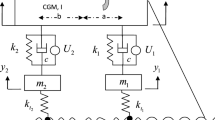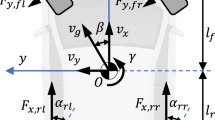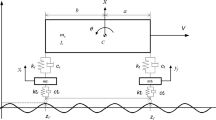Abstract
This paper presents the road simulator control technology for reproducing a road input signal to implement real road data. The simulator consists of a hydraulic pump, a servo valve, a hydraulic actuator and its control equipment. QFT (Quantitative Control Theory) is utilized to control the simulator effectively. The control system illustrates a tracking performance of the closed-loop controller with a low order transfer function G(s) and a pre-filter F(s) for a parametric uncertainty model. A force controller is designed to communicate the control signal between the simulator and digital controller. Tracking specification is satisfied with upper and lower bound tolerances on the steep response of the system to the reference signal. The efficacy of the QFT force controller is verified through the numerical simulation in which combined dynamics and actuation of the hydraulic servo system are tested. The simulation results show that the proposed control technique works well under an uncertain hydraulic plant system. The conventional software (Labview) is used to make up for the real controller on a real-time basis, and the experimental works show that the proposed algorithm works well for a single road simulator.
Similar content being viewed by others
References
Borghesani, C. (1993). Computer Aided Design of Robust Control Systems Using the Quantitative Feedback Theory. M. S. Thesis. Mechanical Engineering Department. University of Massachusetts. Amherst. MA.
Chait, Y. and Hollot, C. V. (1990). A comparison between H methods and QFT for a single-loop plant with both parametric uncertainty and performance specifications. Recent Development in Quantitative Feedback Theory, ASME WAM Conf.., O.D.I. Nwokah, ed. 33–40.
Chait, Y. and Yaniv, O. (2003). Quantitative Feedback Theory Toolbox User’s Guide. Terasoft Inc. Natick. Mass. USA.
Du, H. and Zhang, N. (2007). Robust controller design for improving vehicle roll control. Int. J. Automotive Technology 8, 4, 445–453.
D’Azzo, J. J. and Houpis, C. H. (1988). Linear Control System Analysis. McGraw-Hill. New York.
Horowitz, I. M. (1963). Synthesis of Feedback Systems. Academic Press. New York.
Horowitz, I. M. and Sidi, M. (1972). Synthesis of feedback systems with large plant ignorance for prescribed timedomain tolerance. Int. J. Control 16, 2, 287–309.
Horowitz, I. M. (1982). Improved design technique for uncertain multi input multi output feedback systems. Int. J. Control 36, 6, 977–988.
Horowitz, I. M. (1992). Quantitative Feedback Theory (QFT). QFT Publication. Colorado.
Jeong, S., Kim, J. and Ryu, S. (2001), A study on operational software development and calibration of multi-axis vibrating testing device. Trans. Korean Society Automotive Engineers 9, 2, 143–151.
Katsuhiko, O. (2002). Modern Control Engineering. Prentice Hall. New Jersey.
Park, M. S. (1994). A New Approach to Multi-variable Quantitative Feedback Theory. Ph. D. Dissertation. University of Massachusetts. Amherst. MA.
Park, M. S. and Lee, J. W. (1998). QFT theory having direct multi-variable system. Trans. Korean Society Mechanical Engineers 22, 3, 562–568.
Shaked, U., Horowitz, I. M. and Glode, S. (1976). Synthesis of multivariable basically non-interacting systems with significant plant uncertainty. Automatica, 12, 61–71.
Thayer, W. J. (1965). Transfer Functions for Moog Servo Valves. Moog Inc. Blacksburg. VA. USA.
Yaniv, O. and Horowitz, I. M. (1986). A quantitative design method for MIMO linear feedback systems having uncertain plants. Int. J. Control, 43, 402–421.
Zang, R., Alleyene and Prasetiwan, E. (2002). Modeling and H2/H MIMO control of an earthmoving power train. ASME J. Dynamic Systems, Measurement and Control 124, 4, 625–636.
Ziegler, J. G. and Nichols, N. B. (1942). Optimum settings for automatic controllers. ASME Trans., 64, 759–768.
Author information
Authors and Affiliations
Rights and permissions
About this article
Cite this article
Kim, J.W., Xuan, D.J. & Kim, Y.B. Design of a forced control system for a dynamic road simulator using QFT. Int.J Automot. Technol. 9, 37–43 (2008). https://doi.org/10.1007/s12239-008-0005-x
Received:
Revised:
Published:
Issue Date:
DOI: https://doi.org/10.1007/s12239-008-0005-x




